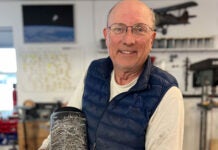Sherrill Kendricks Sonex

On February 20, 2007, at Morganton-Lenoir Airport in North Carolina, N43566 took to the air for the first time. Plans set 688 is a trigear trainer version with the AeroVee engine. The flight went well with no surprises, thank goodness. Oil temperature was 190 (no oil cooler yet, but maybe this summer Ill add one if necessary); oil pressure was 25 psi. Cylinder head temperatures were about 325 (monitoring the two rear cylinders only); OAT was about 50. I climbed out at 80 mph, flew for about 45 minutes, getting the feel for the plane and getting comfortable. Handling was not a problem; the landing was about a seven on a scale of 10. The whole experience was great. Just think, I put every piece of the plane together myself. Tremendous satisfaction. This has been my fourth airplane project and the most satisfying one to date. Everyone at Sonex has been wonderful to deal with. They are first class in all respects. To those of you who are still in the building process, keep at it. It is the most fun and economical flying you can possibly do.
sherril_k_2002@yahoo.com
Jim Reeds Challenger II
This is a Challenger II recently completed by myself, a 70-year-old first-time builder. The kit is by Quad City Ultralights of Moline, Illinois. Its a two-passenger tandem, powered by a Rotax 503 dual-carb, dual-ignition engine. It qualifies as a Light Sport Aircraft, Experimental category. It cruises at 65 to 75 mph, has a 10-gallon fuel tank, and consumes about 4 gph at cruise. Construction and painting were done entirely in my garage over a one-year period, with wing and engine installation accomplished where it is now hangared at Tokeena Air Park in Townville, South Carolina. The covering is Stits 1.7-ounce material with PolyFiber/Polytone paint.

Pendleton, South Carolina
jdupre@bellsouth.net
Walt Westers GlaStar

241WW was completed in 1999 in trigear format and flown that way for about three years. Being a commercial seaplane pilot, I couldn’t stand it not being flown on floats. Its powered by a Lycoming O-360 and, now that it is a seaplane, sports an 82-inch MT CS propeller. The floats are 1900 Czech amphibs, ostensibly designed for the GlaStar. It is hard to beat water for fun, and I love to taxi up to docks with motorboats and jet skis and know that I can leave all that traffic behind. Floats do slow a plane down considerably, but to most of my destinations, I can beat the majority of wheeled airplanes. In fact, theyd need a car, a boat and a guide to get to most of them.
Larkspur, California
WaltWester@earthlink.net
Builders Share Their Successes
Submissions to “Completions” should include a typed, double-spaced description (a few paragraphs only-250 words maximum) of the project and the finished aircraft. Also include a good color photograph (prints or 35mm slides are acceptable) of the aircraft that we may keep. Please include a daytime phone number where we can contact you if necessary. Also indicate whether we may publish your address in case other builders would like to contact you. Send submissions to: Completions, c/o KITPLANES Magazine, 203 Argonne Ave., Suite B105, Long Beach, CA 90803. Digital submissions are also acceptable. Send text and photos to editorial@kitplanes.com with a subject line of “Completions.” Photos must be high-resolution-300 dpi at a 3 x 5 print size is the minimum requirement.













